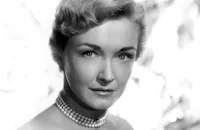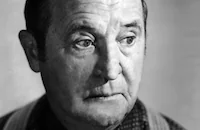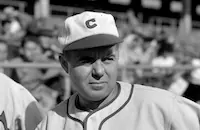The Guilt of Janet Ames

Brief Synopsis
Cast & Crew
Henry Levin
Rosalind Russell
Melvyn Douglas
Sid Caesar
Betsy Blair
Nina Foch
Film Details
Technical Specs

Synopsis
Janet Ames, a distraught war widow, wanders through city streets in a daze, carrying her husband's Congressional Medal of Honor and searching for five men who were in her husband's regiment. While crossing a busy street, Janet is struck by an automobile and taken to a hospital, where her case is listed as a possible attempted suicide. As Janet lies unconscious in the hospital, the police try to determine her identity by questioning the men listed on a piece of paper found in her possession. The first to be questioned is an unemployed and disillusioned reporter, Smithfield "Smitty" Cobb. Smitty introduces himself to the recovering Janet as a friend of her husband David but does not reveal that he is one of the men she is seeking. Instead, Smitty listens as Janet explains that she wants to meet the five men whose lives David saved on a battlefield when he threw himself on a live grenade. She tells him that she wants to meet them to confirm her suspicions that her husband died in vain, sacrificing his life for five worthless men. Offended by her objective, Smitty responds angrily and tells her that she is full of self-pity. He then recalls the lesson of George du Maurier's novel Peter Ibbetson and decides to change Janet's perception of her husband's sacrifice by hypnotizing her and taking her on an imaginary journey into the lives of each of the men on her list: The first destination on Janet's journey is a visit with Joe Burton and his girl friend Katie, who show her their plans to build a house. Their plans are constructed from a deck of playing cards, which Janet blows down to illustrate the foolishness of their aspirations. When Smitty brings Janet out of her hypnotic state, he analyzes her journey and asks her if David had plans to build a house before he died. Smitty next takes Janet on a journey to the desert, where Edgar Pierson works as a scientist and lives in a shack with his wife Susie. Janet observes a scene in which Susie's father drives by in a chauffeured car and criticizes her husband's lifestyle and his lack of interest in the corporate world. Janet responds to her observation of the scene by saying that David would never have made such sacrifices. Janet's next journey is to Frank Merino's walled garden in Glendale, California, where Janet talks with his young daughter Emmy about her dolls and child rearing. Janet quickly becomes defensive, insisting that David was too sensible to have children. Smitty then takes Janet to the fourth man on the list, comedian Sammy Weaver, who, while performing at a nightclub, thanks Janet for saving his life. By the end of her last journey, Janet confesses to Smitty that she knew his true identity all along. She then kisses Smitty and thanks him for showing her that she alone is to blame for the fact that David did not realize his dreams of building a house, having a child and getting a better job. As soon as Janet realizes this, she finds the key to her paralysis and suddenly regains the use of her legs. She then helps Smitty regain his self-respect by coaxing him to confess that he gave David the command to dive onto the grenade. Janet forgives David and, having fallen in love with Smitty, suggests they conjure up hypnotic images of their happy future together.

Cast

Rosalind Russell

Melvyn Douglas

Sid Caesar
Betsy Blair

Nina Foch
Charles Cane
Harry Von Zell
Bruce Harper
Arthur Space

Richard Benedict

Frank Orth

Ray Walker
Doreen Mccann
Hugh Beaumont
Thomas Jackson
Edwin Cooper
Emory Parnell
Victoria Horne
Wanda Perry
Kathleen O'malley

Eve March
Pat Lane
Fred Howard
Steve Benton
Doris Colleen
William Trenk
George Riley
John Farrell
Bill Wallace
John Berkes
William Challee
Michael Towne
William Forrest
Isabel Withers
Denver Pyle
Crew
Travis Banton
Clay Campbell
Lenore Coffee
Helen Deutsch
George Duning
Milton Feldman
Doris Fisher
Devery Freeman
Frank Goodwin
Stephen Goossón
Walter Holscher
Helen Hunt
Rose Loewinger
Jean Louis
William Lyon
Louella Macfarlane
George Montgomery
Charles Nelson
Allen Rivkin
Allan Roberts
M. W. Stoloff
Frank [a.] Tuttle
Virginia Van Upp
Joseph Walker

Film Details
Technical Specs

Articles
The Guilt of Janet Ames
Russell had been playing mostly comedy roles since her rollicking performance as the catty Sylvia in MGM's The Women (1939). When her contract with MGM ended in 1941, Russell wanted more varied roles and decided to freelance. She worked for various studios, but she was still being offered mostly roles in comedies, usually playing a glamorous career woman tamed by love. Only Roughly Speaking (1945) at Warner Bros. gave her a well-rounded character to play, including both drama and comedy. At RKO, her dramatic performance as the Australian nurse who devised a treatment for polio in Sister Kenny (1946) earned her an Oscar® nomination. The Guilt of Janet Ames, her first drama at Columbia after several comedies, also seemed to offer a dramatic challenge. It would re-unite Russell with Melvyn Douglas, who would be making his first film since returning from serving in World War II, and with whom she had co-starred in the sparkling romantic comedy This Thing Called Love (1940). However, The Guilt of Janet Ames turned out to be a troubled production that did nothing for either of their careers.
The original director assigned to The Guilt of Janet Ames was Charles Vidor. But he and producer Virginia Van Upp (with whom he had just finished making Gilda, 1946) disagreed about the script. Vidor was also suing Columbia to terminate his contract. Van Upp collapsed from the stress, and production closed down for two weeks while a replacement for Van Upp was selected and script changes were made. Vidor refused to work with Van Upp's replacement, Helen Deutsch. Deutsch also asked to be taken off the picture, but Columbia boss Harry Cohn refused, and issued a statement supporting her (Neither Deutsch nor Van Upp has an onscreen credit). Henry Levin eventually received credit for directing the film, and Vidor lost his suit against Columbia, which in turn sued him. Vidor eventually bought out his contract in 1948.
In her book A Woman's View (1993), film historian Jeanine Basinger provides a feminist analysis of The Guilt of Janet Ames as a case study in attitudes towards women in the films of the 1940s. Basinger believes that the film "is not meant to be subversive, but to reaffirm a woman's traditional role. That it appeared in 1947, just as women who had worked during World War II were being asked to settle back down in their roles at home, may be significant."
That kind of analysis, of course, was decades away. Contemporary critics found The Guilt of Janet Ames dull, in spite of its stylish dream sequences. According to the New York Times, what it "lacks in large doses is dramatic interest, and there isn't much the principals, Rosalind Russell and Melvyn Douglas, can do about that. The producer and director should have spotted the weakness in the script and sent it back for rewriting." The Times critic, did, however, have kind words for a young newcomer: "A lunatic note of comedy is attained when the elastic-faced Sid Caesar appears doing an energetic burlesque of psychiatrists and psychoanalysis. A very funny man, this Mr. Caesar."
The Guilt of Janet Ames was the 25-year old Caesar's second film. His first was Tars and Spars (1946), a film version of a musical military revue. Caesar, a talented saxophonist, had a musical role in the show until producer Max Liebman noticed him improvising comedy routines, and gave him a spot doing comedy. Caesar had grown up working in his immigrant father's New York diner, and had picked up accents from the immigrants who frequented it. The pseudo-Viennese accent he uses in his routine in The Guilt of Janet Ames was just one of the many accents that he would use throughout his career. Caesar left Hollywood for New York soon after making The Guilt of Janet Ames, and a few years later, his Tars and Spars producer Max Liebman would star him in the television variety show, Your Show of Shows. Caesar became one of television's top stars, and would not appear in another film until 1963's It's A Mad, Mad, Mad, Mad World.
Two other newcomers made their film debuts in The Guilt of Janet Ames. Betsy Blair, who plays the girlfriend of the bouncer in the first dream sequence, had been a Broadway actress before going to Hollywood as the bride of Gene Kelly in the early 1940s. She spent several years raising their daughter before returning to acting. Her best role would be as the gentle love interest in Marty (1955). Future film and television character actor Denver Pyle made his screen bow in a small but pivotal role. Watch for him as a man who tries to pick up Janet in the first scene of the film, as she waits to cross the street. He's not listed in the onscreen credits, but printed credits refer to his character as "Masher."
Director: Henry Levin
Screenplay: Devery Freeman, Louella MacFarlane, Allen Rivkin; Lenore J. Coffee (story)
Cinematography: Joseph Walker
Art Direction: Stephen Goosson, Walter Holscher
Music: George Duning
Film Editing: Charles Nelson
Cast: Rosalind Russell (Janet Ames), Melvyn Douglas (Smithfield Cobb), Sid Caesar (Sammy Weaver), Betsy Blair (Katie), Nina Foch (Susie Pearson), Charles Cane (Walker), Harry von Zell (Carter), Bruce Harper (Junior), Richard Benedict (Joe Burton).
BW-83m.
by Margarita Landazuri

The Guilt of Janet Ames
Quotes
Trivia
Notes
The working title for this film was My Empty Heart. The picture was actor Melvyn Douglas' first film following three years in the Army, and marked the feature film debut of actors Harry Von Zell and Betsy Blair. A May 1946 Hollywood Reporter news item noted that producer Virginia Van Upp's husband, Ralph Nelson, also a producer, was set to work on the film, but his contribution to the released film has not been confirmed. Various news items in Hollywood Reporter indicate that production on the film was interrupted many times throughout the summer and fall of 1946, and that Van Upp and Charles Vidor, the film's original director, were embroiled in a bitter dispute about the script. [In April 1946, Vidor, while working on the film Gilda, sued Columbia for termination of his contract. The suit was part of a long-standing dispute with studio executives and personnel that spanned many years.] Production on the film was suspended for approximately two weeks in mid-August 1946, after, according to a Hollywood Reporter news item, Van Upp collapsed on the set. Van Upp was removed from the picture, and a Hollywood Reporter news item suggested that her troubles stemmed from player commitments that forced her to begin filming the picture before the script was completed. Helen Deutsch took over Van Upp's production chores and, during the two-week production shutdown, supervised a series of script revisions and additions.
An September 18, 1946 Hollywood Reporter news item, noted that Vidor then became involved in a major dispute with Deutsch, whose supervision he was reportedly refusing. On September 24, 1946, Hollywood Reporter printed a statement issued by Columbia production chief Harry Cohn, in which Cohn stated "emphatically and clearly that Miss Helen Deutsch is the producer of the picture and that Mr. Charles Vidor is not." The statement also reveals that Deutsch had asked to be relieved of her duties, and that Cohn insisted that she remain on the film. Vidor's suit against Columbia went to trial in December 1946, at which time, according to Hollywood Reporter, Vidor testified that Cohn made derogatory remarks to him and vilified his wife, Doris Warner. According to a September 1947 Hollywood Reporter news item, Vidor lost his suit against Columbia, and Columbia then sued Vidor. For more information on Vidor's troubles with Columbia, see Gilda (above) and The Man from Colorado (below).
In Peter Ibbetson, the 1891 George Du Maurier novel mentioned in the film, the hero communicates with his childhood sweetheart in a dream and changes his perspective on life as a result of the experience. For more information on the Du Maurier novel and its adaptation to film, see the entry for the 1935 Paramount picture Peter Ibbetson in the AFI Catalog of Feature Films, 1931-40; F3.3431. In the final dream sequence of The Guilt of Janet Ames, Sid Caeser performs a comedy sketch satirizing psychological screen drama. Some filming took place in the Mojave Desert, CA. This film marked the screen debut of actor Denver Pyle.
















